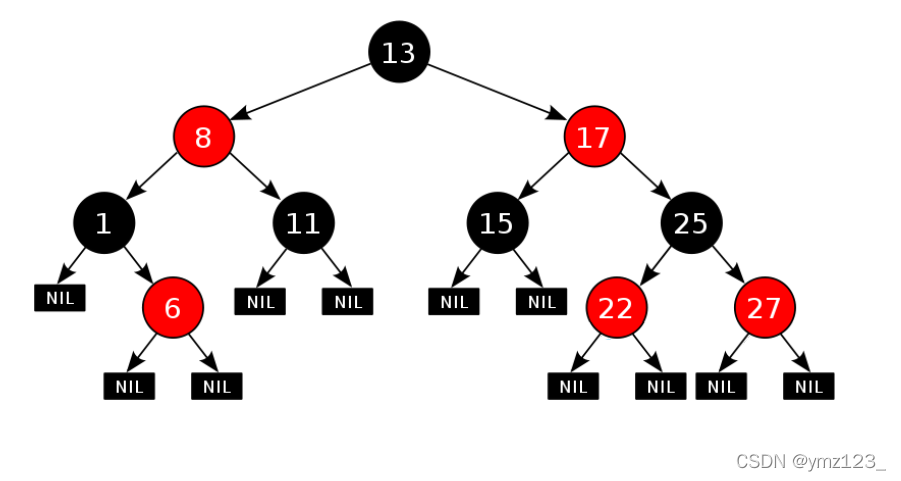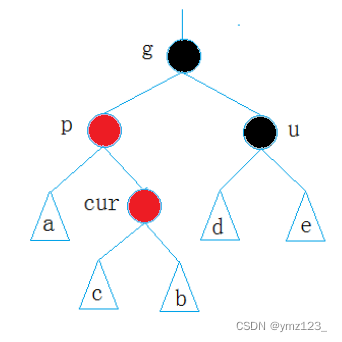红黑树
红黑树的概念
红黑树的概念 红黑树,是一种二叉搜索树,但在每个结点上增加一个存储位表示结点的颜色,可以是Red或Black。 通过对任何一条从根到叶子的路径上各个结点着色方式的限制,红黑树确保没有一条路径会比其他路径长出俩倍,因而是接近平衡的。
红黑树和AVL树都是高效的平衡二叉树,增删改查的时间复杂度都是O(),红黑树不追求绝对平衡,其只需保证最长路径不超过最短路径的2倍,相对而言,降低了插入和旋转的次数,所以在经常进行增删的结构中性能比AVL树更优,而且红黑树实现比较简单,所以实际运用中红黑树更多。

红黑树的性质
- 每个结点不是红色就是黑色
- 根节点是黑色的
- 如果一个结点是红色的,则它的两个孩子结点是黑色的
- 对于每个结点,从该节点到其所有后代叶节点的简单路径上,均包含相同数目的黑色结点
- 每个叶子结点都是黑色的(此处的叶子节点指的是空结点,如上图路径数为11条)
红黑树结点的定义
enum Color {
BLACK,
RED
};
template<class T>
struct RBTreeNode
{
RBTreeNode<T>* _left;
RBTreeNode<T>* _right;
RBTreeNode<T>* _parent;
Color _col;
T _data;
RBTreeNode(const T& data)
: _left(nullptr)
, _right(nullptr)
, _parent(nullptr)
, _col(RED)
,_data(data)
{}
};
红黑树的插入操作
约定:cur为当前节点,p为父节点,g为祖父节点,u为叔叔节点
情况一
- 情况一:cur为红,p为红,g为黑,u存在且为红
注意:此处看到的树,可能是一棵完整的树,也可能是一棵子树 - 解决方式:将p,u改为黑,g改为红,然后把g当成cur,继续向上调整
如果g是根节点,调整完成后,需要将g改为黑色
如果g是子树,g一定有双亲,且g的双亲如果是红色,需要继续向上调整。



情况二
- 情况二:cur为红,p为红,g为黑,u不存在/u为黑
- 解决方法:p为g的左孩子,cur为p的左孩子,则进行右单旋;p为g的右孩子,cur为p的右孩子,则进行左单旋。
p变黑,g变红。
1.如果u节点不存在,则cur一定是新插入节点,因为如果cur不是新插入节点,则cur和p一定有一个节点的颜色是黑色,就不满足性质4:每条路径黑色节点个数相同。
2.如果u节点存在,则其一定是黑色的,cur一定不是新增节点,那么cur节点原来的颜色一定是黑色的,是作为子树的祖父,由第一种情况变化过来的


情况三
- 情况三:cur为红,p为红,g为黑,u不存在/u为黑(折线型)
- p为g的左孩子,cur为p的右孩子,则针对p做左单旋转;
p为g的右孩子,cur为p的左孩子,则针对p做右单旋转。
即转换为了情况二。再对g做对于旋转。
即进行双旋转。


// T->K set
// T->pair<const K, V> map
template<class K, class T, class KeyOfT>
class RBTree
{
typedef RBTreeNode<T> Node;
public:
typedef RBTreeIterator<T, T&, T*> iterator;
typedef RBTreeIterator<T, const T&, const T*> const_iterator;
iterator begin();
iterator end();
RBTree()
:_root(nullptr)
{}
// 拷贝构造和赋值重载
// 析构
Node* Find(const K& key);
pair<iterator, bool> Insert(const T& data)
{
if (_root == nullptr)
{
_root = new Node(data);
_root->_col = BLACK;
return make_pair(iterator(_root), true);
}
Node* parent = nullptr;
Node* cur = _root;
KeyOfT kot;
while (cur)
{
if (kot(cur->_data) < kot(data))
{
parent = cur;
cur = cur->_right;
}
else if (kot(cur->_data) > kot(data))
{
parent = cur;
cur = cur->_left;
}
else
{
return make_pair(iterator(cur), false);
}
}
// 新增节点,颜色是红色,可能破坏规则3,产生连续红色节点
cur = new Node(data);
Node* newnode = cur;
cur->_col = RED;
if (kot(parent->_data) < kot(data))
{
parent->_right = cur;
cur->_parent = parent;
}
else
{
parent->_left = cur;
cur->_parent = parent;
}
// 控制近似平衡
while (parent && parent->_col == RED)
{
Node* grandfather = parent->_parent;
if (parent == grandfather->_left)
{
Node* uncle = grandfather->_right;
// 情况一:uncle存在且为红,进行变色处理,并继续往上更新处理
if (uncle && uncle->_col == RED)
{
parent->_col = uncle->_col = BLACK;
grandfather->_col = RED;
cur = grandfather;
parent = cur->_parent;
} // 情况二+三:uncle不存在,或者存在且为黑,需要旋转+变色处理
else
{
// 情况二:单旋+变色
if (cur == parent->_left)
{
RotateR(grandfather);
parent->_col = BLACK;
grandfather->_col = RED;
}
else // 情况三:双旋 + 变色
{
RotateL(parent);
RotateR(grandfather);
cur->_col = BLACK;
grandfather->_col = RED;
}
break;
}
}
else // (parent == grandfather->_right)
{
Node* uncle = grandfather->_left;
if (uncle && uncle->_col == RED)
{
parent->_col = uncle->_col = BLACK;
grandfather->_col = RED;
cur = grandfather;
parent = cur->_parent;
}
else
{
if (parent->_right == cur)
{
RotateL(grandfather);
parent->_col = BLACK;
grandfather->_col = RED;
}
else
{
RotateR(parent);
RotateL(grandfather);
cur->_col = BLACK;
grandfather->_col = RED;
}
break;
}
}
}
_root->_col = BLACK;
return make_pair(iterator(newnode), true);
}
void RotateR(Node* parent);
void RotateL(Node* parent);
private:
Node* _root;
};
红黑树的验证
红黑树的检测分为两步:
- 检测其是否满足二叉搜索树(中序遍历是否为有序序列)
- 检测其是否满足红黑树的性质
此处用未改造过的红黑树
template<class K, class V>
struct RBTreeNode
{
RBTreeNode<K, V>* _left;
RBTreeNode<K, V>* _right;
RBTreeNode<K, V>* _parent;
Colour _col;
pair<K, V> _kv;
RBTreeNode(const pair<K, V>& kv)
:_left(nullptr)
, _right(nullptr)
, _parent(nullptr)
, _col(RED)
, _kv(kv)
{}
};
template<class K, class V>
class RBTree
{
typedef RBTreeNode<K, V> Node;
public:
RBTree()
:_root(nullptr)
{}
bool Insert(const pair<K, V>& kv);
void RotateR(Node* parent);
void RotateL(Node* parent);
void _InOrder(Node* root)
{
if (root == nullptr)
{
return;
}
_InOrder(root->_left);
cout << root->_kv.first << " ";
_InOrder(root->_right);
}
void InOrder()
{
_InOrder(_root);
cout<<endl;
}
bool CheckRED_RED(Node* cur)
{
if (cur == nullptr)
{
return true;
}
if (cur->_col == RED && cur->_parent->_col == RED)
{
cout << "违反规则三,存在连续的红色节点" << endl;
return false;
}
return CheckRED_RED(cur->_left)
&& CheckRED_RED(cur->_right);
}
// 检查每条路径黑色节点的数量
bool CheckBlackNum(Node* cur, int blackNum, int benchmark) {
if (cur == nullptr) {
if (blackNum != benchmark){
cout << "违反规则四:黑色节点的数量不相等" << endl;
return false;}
return true;
}
if (cur->_col == BLACK)
++blackNum;
return CheckBlackNum(cur->_left, blackNum, benchmark)
&& CheckBlackNum(cur->_right, blackNum, benchmark);
}
bool IsBalance()
{
if (_root == nullptr)
{
return true;
}
if (_root->_col == RED)
{
cout << "根节点是红色,违反规则二" << endl;
return false;
}
// 算出最左路径的黑色节点的数量作为基准值
int benchmark = 0;
Node* cur = _root;
while (cur)
{
if (cur->_col == BLACK)
{
++benchmark;
}
cur = cur->_left;
}
int blackNum = 0;
return CheckRED_RED(_root) && CheckBlackNum(_root, blackNum, benchmark);
}
private:
Node* _root;
};
void TestRBTree1()
{
const int n = 1000000;
vector<int> a;
a.reserve(n);
srand(time(0));
for (size_t i = 0; i < n; ++i)
{
a.push_back(rand());
}
RBTree<int, int> t1;
for (auto e : a)
{
t1.Insert(make_pair(e, e));
}
cout << t1.IsBalance() << endl;
//t1.InOrder();
}
用红黑树封装map、set
红黑树的迭代器
begin()与end()
begin()可以放在红黑树中最小节点(即最左侧节点)的位置
end()放在最大节点(最右侧节点)的下一个位置
typedef RBTreeIterator<T, T&, T*> iterator;
typedef RBTreeIterator<T, const T&, const T*> const_iterator;
iterator begin()
{
Node* left = _root;
while (left && left->_left)
{
left = left->_left;
}
//return left
return iterator(left);
}
iterator end()
{
return iterator(nullptr);
}
操作符重载
template<class T, class Ref, class Ptr>
struct RBTreeIterator
{
typedef RBTreeNode<T> Node;
typedef RBTreeIterator<T, Ref, Ptr> Self;
Node* _node;
RBTreeIterator(Node* node = nullptr)
:_node(node)
{}
Ref operator*()
{
return _node->_data;
}
Ptr operator->()
{
return &_node->_data;
}
Self& operator--()
{
// 跟++基本是反过来
return *this;
}
Self& operator++()
{
if (_node->_right)
{
// 右子树中序第一个节点,也就是右子树的最左节点
Node* subLeft = _node->_right;
while (subLeft->_left)
{
subLeft = subLeft->_left;
}
_node = subLeft;
}
else
{
// 当前子树已经访问完了,要去找祖先访问,沿着到根节点的路径往上走,
// 找孩子是父亲左的那个父亲节点
Node* cur = _node;
Node* parent = cur->_parent;
while (parent && parent->_right == cur)
{
cur = parent;
parent = parent->_parent;
}
_node = parent;
}
return *this;
}
bool operator!=(const Self& s) const
{
return _node != s._node;
}
bool operator==(const Self& s) const
{
return _node == s._node;
}
};
封装map
#pragma once
#include "RBTree.h"
namespace MyMap
{
template < class K, class V>
class map
{
struct MapKeyOfT
{
const K& operator()(const pair<const K, V>& kv)
{
return kv.first;
}
};
public:
typedef typename RBTree<K, pair<const K, V>, MapKeyOfT>::iterator iterator;
iterator begin()
{
return _t.begin();
}
iterator end()
{
return _t.end();
}
pair<iterator, bool> insert(const pair<const K, V>& kv)
{
return _t.Insert(kv);
}
V& operator[](const K& key)
{
pair<iterator, bool> ret = _t.Insert(make_pair(key, V()));
return ret.first->second;
}
private:
RBTree<K, pair<const K, V>, MapKeyOfT> _t;
};
void test_map()
{
map<string, string> dict;
dict.insert(make_pair("sort", "排序"));
dict.insert(make_pair("string", "字符串"));
dict.insert(make_pair("debug", "找虫子"));
dict.insert(make_pair("set", "集合"));
map<string, string>::iterator it = dict.begin();
while (it != dict.end())
{
cout << it->first << ":" << it->second << endl;
++it;
}
cout << endl;
}
}
封装set
#pragma once
#include "RBTree.h"
namespace MySet
{
template < class K>
class set
{
struct SetKeyOfT
{
const K& operator()(const K& key)
{
return key;
}
};
public:
typedef typename RBTree<K, K, SetKeyOfT>::iterator iterator;
iterator begin()
{
return _t.begin();
}
iterator end()
{
return _t.end();
}
pair<iterator, bool> insert(const K& key)
{
return _t.Insert(key);
}
private:
RBTree<K, K, SetKeyOfT> _t;
};
void test_set()
{
set<int> s;
s.insert(1);
s.insert(3);
s.insert(7);
s.insert(2);
s.insert(12);
s.insert(22);
s.insert(2);
s.insert(23);
s.insert(-2);
s.insert(-9);
s.insert(30);
set<int>::iterator it = s.begin();
while (it != s.end())
{
cout << *it << " ";
++it;
}
cout << endl;
for (auto e : s)
{
cout << e << " ";
}
cout << endl;
}
}